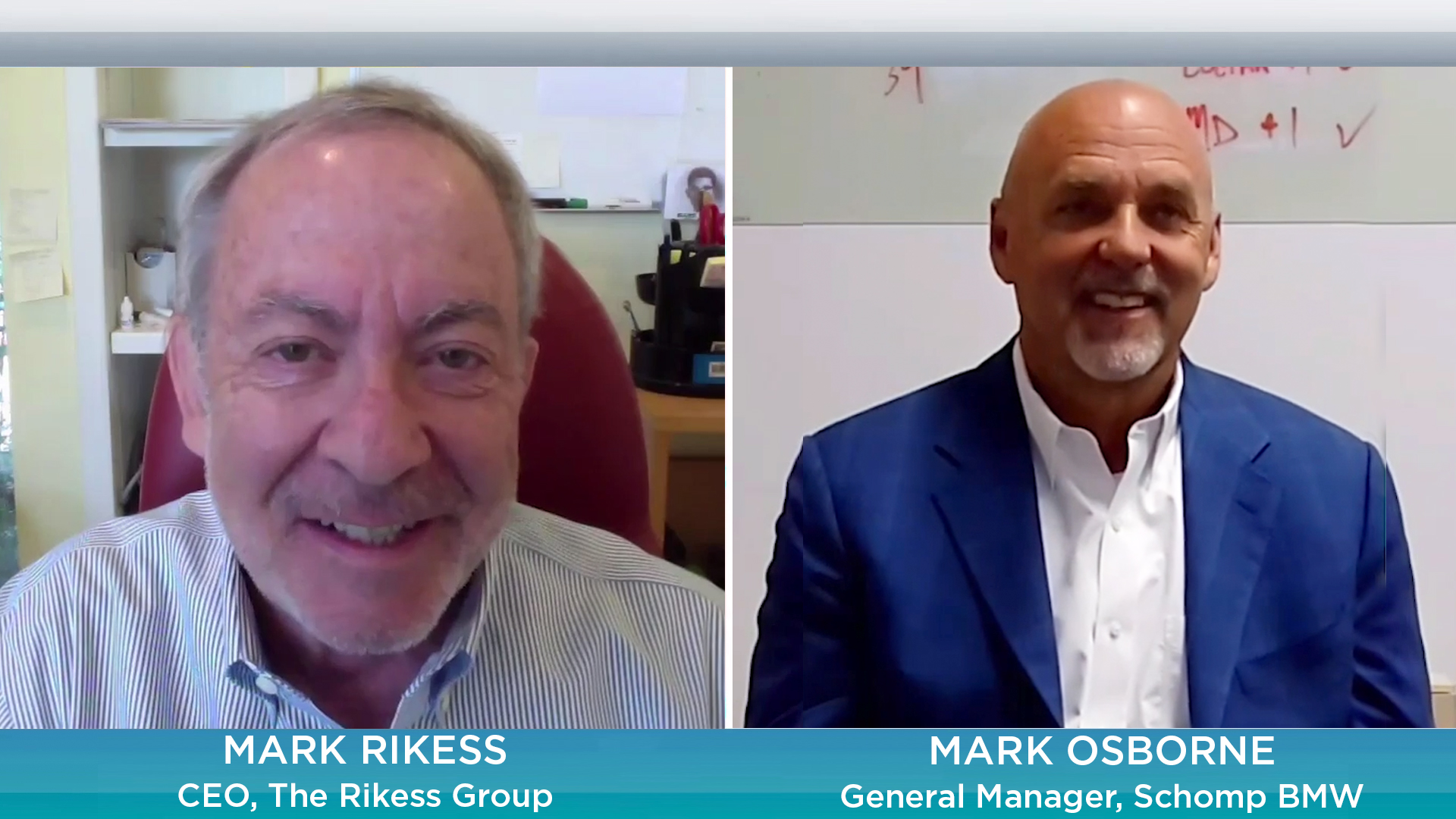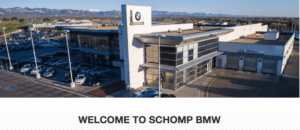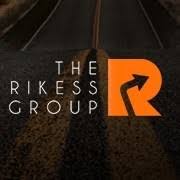In today’s digital landscape, more and more customers turn to websites, forums, and reviews to find reliable and transparent data. However, with a one-price selling model, the dealer and the customer are working with the same exact information, which creates a trusting and loyal relationship. We recently spoke to Mark Rikess, CEO of The Rikess Group, and Mark Osborne, GM of Schomp BMW in Denver, to discuss the benefits of a one-price selling model, and how you can have optimal control over your dealership.
Jim Fitzpatrick: Today, I’m excited to bring into the show, Mr. Mark Rikess, CEO of the Rikess Group, and along with him Mr. Mark Osborn, GM of Shop BMW in Denver, Colorado. Gentlemen, thank you so much for joining us on CBT News today.
Mark Rikess: Glad to be here.
Jim Fitzpatrick: Sure, so let’s kind of dive right in here. Mark, you’re a one price dealership and have been since really the early 90’s, based on what you said to me before the camera started rolling today, right?
Mark Osborne: Correct. Yes, since 1993.
Jim Fitzpatrick: Sure. You’re like one of the founding fathers of one price, right?
Mark Osborne: Never thought of it that way, but I think that’s accurate, along with Mark.
Jim Fitzpatrick: What do you see as the biggest advantage of being a one price dealer today, for the dealers that are watching and the managers that are shaking their head going either, “I’m completely sold on one price. I too, do it,” or “Never can it be done in my market.”
Mark Osborne: It’s the ability to be transparent that makes it so much easier. The market, we’ve see it in used cars, it’s just naturally happening with all the technology and the market pricing, and all the availability to know where you’ve got to be on price. It’s not really that different from new cars. It’s just so pleasant for our employees to not hide anything. There’s no games, it’s just complete transparency.
Jim Fitzpatrick: Sure. For the dealers that are watching, isn’t it true that you lose deals to your competitors, because you won’t negotiate on price?
Mark Osborne: Very rarely. We have a wide variety of pricing, actually. Mark taught us 25 years ago that it’s a natural formula for when you have a car we’ve had in stock longer, those are our specials, and it’s worked from day one. It’s worked for 25 years, so we really rarely miss a deal on price.
Jim Fitzpatrick: Mark, you say 25 years ago, that’s obviously before the internet, or I guess the internet started to come in around the mid 90’s, 97′, 98′ to really play a role in auto retailing, but in 1993, we didn’t really have the internet as an issue out there, right? Here you are converting dealerships to one price selling when we didn’t even maybe have to. Talk to us about that.
Mark Rikess: Yeah, I think a lot of it started with Saturn. Saturn came out with a not a great car, but a great process and customers flocked and bought Saturn. That’s sort of what catalyzed me to start the one price practice. Because of the success of Saturn and creating loyal customers, dealers were more open-minded to say, “I guess this is what the customer wants.” Without all the technology background, we were able to convert a number dealerships and there was some information that they cd use, like Auto Trader, Kelley Blue Book, that there were some estimates here and there. Mystery shops, but the pricing, because the customers didn’t have perfect pricing, all it had to be was highly competitive and create a great experience, and people stopped shopping.
Jim Fitzpatrick: Sure, sure. What would you say are the top couple of reasons for adopting a one price sales process?
Mark Rikess: Well, I think the number one is the customer. At some point, we really need to do more on what the consumer wants. All the studies are saying that consumers want a fast, simple, transparent process. You really can’t beat transparent and negotiate, because you’re saying “This is the best price we can sell the car for,” when it really isn’t the best price. That’s not a transparent process, but probably equal to, is the ability to attract millennials and women in particular, talented millennials and talented women. In our industry, there’s a big hindrance in attracting those types, because they don’t understand negotiations, they don’t want to negotiate. In our one price pointing group, the data is 65% of the sales people in our once price pointing group stores are millennials and 21% are women. National average, women salespeople in dealerships is 3%.
Jim Fitzpatrick: Wow. Mark Osborn, do you see that to be the case, that you’re able to attract a better quality candidate and salesperson on the showroom floor, and perhaps more females into your dealership to sell for you, because of the one price?
Mark Osborne: Absolutely. They’re more comfortable. It’s pretty easy to see it when they are interested in working for us, that it’d be comfortable. They want to do the things that they’ve had experiences buying cars in the past. They’re very comfortable and we have, Mark’s numbers were almost identical to that with millennials and women. It’s wonderful.
Jim Fitzpatrick: Really? Does one price mean that you’re not going to be able to be a volume dealer?
Mark Osborne: Not at all. Our stores are some of the highest volume stores in the country. Our BMW store’s in the top 20 in the country. Our Honda store’s in the top 20 in the country. Our Subaru store’s number one and number two in the United States. Our Mini store’s number two in the United States. The rest of our stores are number one in the state.
Jim Fitzpatrick: That’s phenomenal. Your tagline at the dealership is, “One person, one price, one hour.” Walk me through that. Explain what exactly that means.
Mark Osborne: Well, traditionally when you go to a dealership, you might get passed around quite a bit.
Jim Fitzpatrick: This is true.
Mark Osborne: People really don’t like that. We were particular about who we hire and the people that can handle the process, so they’re capable of handling the whole process. When we say one person, they handle the financing, they deliver the car, they do everything. Obviously, the one price, we put our best price on the car. One hour is once they select a car that we have in stock, we’ll get them out of the dealership in an hour.
Jim Fitzpatrick: Which is a huge factor today, isn’t it?
Mark Osborne: Time is huge. In the first 20 seconds, when a customer comes to our dealership, we make sure they understand that the biggest thing that we value is their time.
Jim Fitzpatrick: Sure. When you converted the dealership over, what was that process like? Typically you’ll get salespeople and managers that convert to a one price selling situation, where you might see 50% or greater of the sales force and management team leave, because they just say, “I’m not a one price person.” Did you find that to be the case when you made the switch?
Mark Osborne: We’ve had two different situations. We’ve always been pretty highly though of in the community and our owners have been very involved in the community, so we had a good reputation, but the one price, the process was a pretty natural fit, so Mark helped us. I did ask him to hold my hand a few time in the process, but it went pretty well. We have transitioned stores that we’ve acquired and they’re not used to our culture. It’s a little more work, but very successful. Our Subaru store, again, we’ve increased the volume of it. I think I looked at the number yesterday, we’re ten cars from being the number one Subaru store in the world this month.
Jim Fitzpatrick: Wow, congratulations. That’s great. It helps with your sales team, your management team, your customers like it more. It helps with referrals, it helps with retaining that customer to come back for future business. What would be any downside of moving to a one price structure for a dealer in your opinion?
Mark Osborne: We’ve been doing it so long, it’s hard for me to bring up any downside, but I think there’s a few customers that still are … they don’t believe it. It’s a really thought out process and when you explain how we come up with the pricing, and that we have cars that, “Hey, if you want a car a real bigger discount, I’ve got a few over here that we’ve had in stock longer.” I’m surprised that we rarely really have a customer or an employee that really brings up a downside to it.
Jim Fitzpatrick: Yeah, that’s great. That’s great. Mark, why don’t more, and this is for Mark Rickis, but why don’t more dealers move to a one price environment?
Mark Rikess: I think the biggest impediment is the middle management that the vast majority of sales managers, GSM, possibly even GM, made their bones negotiating. They take pride in that. That’s what they know how to do. They’re basically deal managers, not people developers, so I think there are a lot of dealers that want to go to one price and they look at their management staff and go, “I’m going to lose a bunch of these people who’ve worked for me for a long time.” There’s going to be some pain and pretty much starting over, a new way of doing business and having to have to get some new managers. I think again, that the demand at the dealer level is high, but their ability to execute with their current management team it feels pretty low.
Jim Fitzpatrick: Sure. We’ve spoken to some dealers here on CBT News that have actually tried one price, but they feel it failed. What are some of the reasons that one price fails after being installed into a store?
Mark Rikess: Yeah, great question. The number one reason is the dealer, the leadership. You’ve got to have a commitment that says, “I believe so strongly in this, if I can’t do it I should get out of the business.” That’s the level of commitment we’re looking for and we’ll turn dealers down if they’re doing it as the next new thing to do, or “I’ve tried everything else, I’ll try this.”
Then the next piece is that middle management. If a dealer group doesn’t lose about a third of their managers or more, I get nervous, because either they don’t have the skill sets to do it, or they don’t have the desire. Often they quit and stay, so they don’t leave the job, they try and outwait the program, and let the dealer finally pull the plug on it, and then they can say, “I was right.” You’ve got to get the right people on the bus, so you’re transitioning, it’s a new world. You’re going to lose a third of your managers, you’re going to bring in managers who’ve never managed in a one price environment, so that part is messy.
Then the third piece is you’ve got to be an alluring organization. This is all about out presenting the competition at every level, so training, training, and more training. Mystery shopping, learning what your competition’s saying about you. You’ve got to be a constantly learning organization to out present the competition.
Jim Fitzpatrick: Mark Osborn, do you feel though this gives you maybe a competitive advantage while we see the industry shifting to digital retailing, because this is kind of really the first step of that, right, is having an environment in a dealership that’s all reading off the same sheet of music in regard to the pricing of the vehicles, as we go further into digital retailing?
Mark Osborn: Yeah, correct. For example, our salespeople take all the leads. They do the whole process. Since all of our prices, we pre-price everything, it’s easy. You can answer a lead super quick. A phone call, you can get right to the point of, “This is our price. Here’s the program.” It’s just the information flows very, very easily.
Jim Fitzpatrick: Sure. Are your salespeople on any kind of a salary plus a unit bonus or commission, or are they paid the conventional way where it’s a percentage of just the front end gross profit?
Mark Osborn: Paid on a percentage of the front end gross. The salary based, bonuses on volume, and they do sell warranties and finance products, so they’re paid on those items also.
Jim Fitzpatrick: Lower cost overall, salespeople like to work there more, customers like it better. The grosses are the same, if not better. You make more money on the back end. If I were a dealer today, I’d have to be going one price, without a doubt. Many of the dealers watching me right now, know that I lean to one price anyway, whenever we have these discussions, but in some point in time, the dealers that are not on board are going to have to sit up and smell the coffee, right? And say, “Hey, this is driven by the customer.” Obviously, kudos to you Mr. Osborn, that you saw this in 1993, because you certainly had some foresight there to say that this is coming, and I think it’s even stronger now than it was in 1993, you’d probably agree is something that all dealers need to take a close look at.
Jim Fitzpatrick: Gentlemen, Mark Rickis, CEO of Rickis Group and Mark Osborn, GM of Shop BMW of Denver, thank you so much for joining us on CBT News to discuss this very hot topic.
Mark Rikess: Thank you, Jim.
Mark Osborne: Thanks for having us.
Jim Fitzpatrick: Thanks so much.










